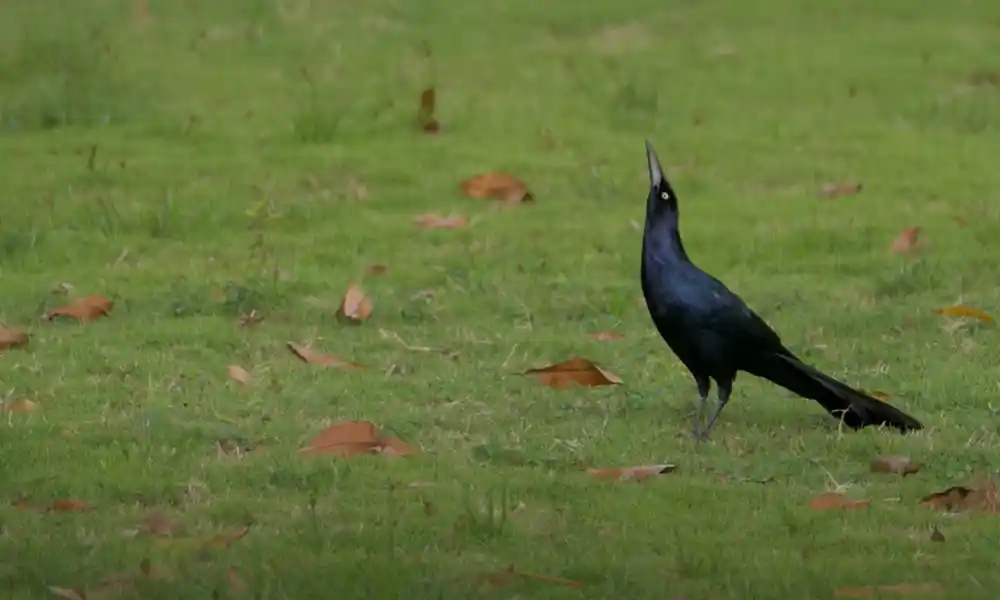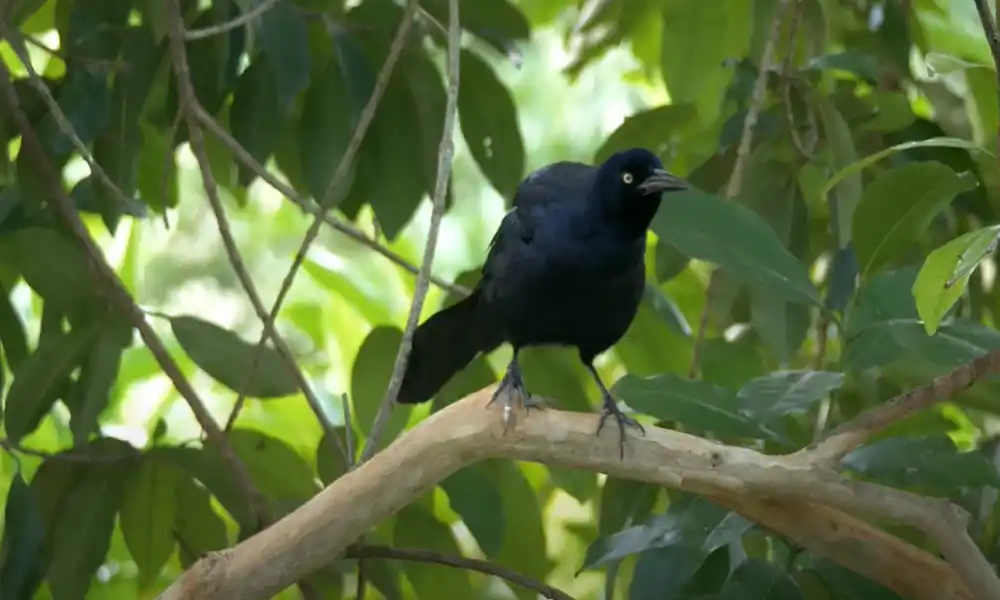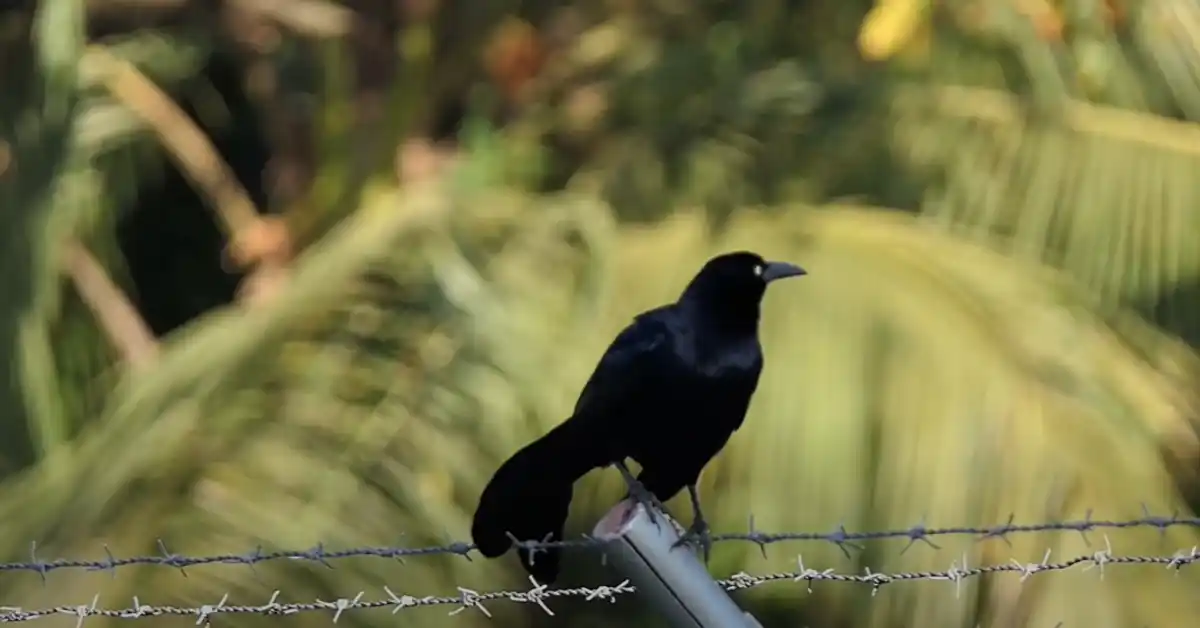Seen a loud black bird with a long tail in Arizona? It’s likely a Great-tailed Grackle. This bold bird walks near cars, parks, and palm trees. It’s shiny, noisy, and easy to spot.
With shiny feathers and a tail that fans out like a flag, this bird owns every space it enters. Let’s explore what makes it so common—and so unforgettable.
Table of Contents
What Is That Loud, Black Bird with a Long Tail in Arizona?
The first time I spotted one, I was walking through a busy parking lot in Tucson. Out of nowhere, this bold black bird strutted across the asphalt like it owned the place. Its tail was long—almost too long for its body. I stopped and thought, “Is that a baby raven or just a flashy crow?”
Turns out, it was a Great-tailed Grackle—and once you know what to look for, you start seeing them everywhere.
These birds are pretty striking, especially the males. They’re jet black with a glossy shine that flashes purple and blue in the sunlight. And that tail? It fans out like a feathered flag, especially when they’re showing off or trying to grab attention. The females are more low-key. They’re smaller, with brown feathers and a more slender tail—but they’re just as feisty.
At first glance, this Arizona black bird with a long tail might look like a crow or raven—but it’s actually a Great-tailed Grackle. But don’t be fooled—grackles are slimmer, flashier, and more noisier. If you are thinking, ‘Is that black bird in Arizona a crow?’, it’s probably a grackle.
I did for years. But grackles are slimmer and move with a lot more attitude. You’ll often hear them before you see them, thanks to their sharp, scratchy calls that sound like a mix of squeaks, whistles, and creaks. They’ve got this quirky energy that makes them stand out.
Now that I know what they are, I notice them all the time—perched on light poles, tucked into palm trees, or casually stealing fries at outdoor cafes. They’re loud, smart, and totally unbothered by people. Honestly, they’ve become one of my favorite parts of daily life in Arizona.
Great-Tailed Grackle Range – Where Can You Spot Them?

I used to think these birds were just an Arizona thing—until I took a trip to Austin and heard that same strange squeaky call echoing through a hotel parking lot. Sure enough, there they were again—Great-tailed Grackles, perched on streetlamps and strutting like they ran the place. That’s when I realized: these birds are everywhere.
Grackles, one of the most common black birds in Arizona, originally came from Central and South America. But over the past century, they’ve spread like wildfire across the Southwest and beyond. You’ll spot them in Arizona, Texas, California, all the way up to Minnesota, and even out east toward Florida.
They thrive in warm places, but they don’t mind the cold either. They’ve figured out how to live anywhere people do. I see them daily in grocery store parking lots, flitting between palm trees and shopping carts, totally unbothered by the crowd. They’ve even turned urban parks into their personal playgrounds.
Whether you’re in Phoenix, San Antonio, or even parts of southern California, there’s a good chance that loud, long-tailed blackbird you’re seeing is a grackle. And once you spot one, you’ll notice them everywhere—from Arizona’s desert strip malls to Texas gas stations, to California boardwalks.
What Sound Does a Grackle Make?
Before you even see the bird in Arizona, you’ll frequently hear a loud, creaking sound. The Great-tailed Grackle, one of the most noticeable black birds in Phoenix and Tucson, calls out to you. I was sitting outside a coffee shop in Phoenix, and out of nowhere came this bizarre squeaky, creaky, almost metallic sound.
For a second, I thought someone’s car was falling apart. But nope—just a grackle, perched above me, making a noise like a rusty hinge with attitude.
The Great-tailed Grackle’s sound is one of the most unique among Arizona birds—loud, scratchy, and impossible to miss. They make all kinds of sounds—whistles, squeaks, and creaks. Some are short. Some drag on like a noisy violin. It’s chaos—but somehow, it works for them.
Here’s something cool: males and females sound different. The males are louder and showier, using their voice to stake claim to territory or impress a mate. Females call too, but they’re more subtle. You’ll often hear them in flocks, chatting in bursts that feel more like gossip than a performance.
If you want to really get a feel for their “playlist,” check out apps like Merlin Bird ID or Xeno-Canto. Just search Great-tailed Grackle, and you’ll find dozens of recordings. It’s honestly wild how much variety one bird species can have.
Now, I’ll be honest—not everyone loves the sound. Some folks find grackles annoying, especially when a flock settles in near your apartment and sings all night like they’re headlining a metal concert. But there’s something oddly charming about their confidence. They’re not trying to be sweet songbirds. They’re here to make noise and be heard.
Arizona Blackbird with Long Tail Pictures
Want to spot an Arizona blackbird with a long tail? Look near palm trees, parking lots, or power lines.. Males shine blue-black, females are brown and sleek. Snap photos of Arizona blackbirds in Phoenix, Tucson, or anywhere in the Sonoran Desert. Early morning light makes their long tails shimmer like ribbons in flight.



Why Grackles Are Smarter Than You Think
I saw a grackle drop bread in a puddle. It waited for it to soak. That’s smart—and shows they use tools. These birds solve problems like tiny feathered engineers. They adapt fast, learn from each other, and thrive in busy places. If you’ve seen one open a chip bag, you know—grackles are way smarter than people give them credit for.
How the Great-Tailed Grackle Differs from Other Blackbirds
At first glance, I thought grackles were just flashy crows. But once I saw one next to a Brewer’s blackbird, the difference was clear. Compared to other Arizona birds that are black, grackles are bigger, louder, and way more dramatic—especially with that crazy long tail. Boat-tailed grackles look similar but hang out near the coast.
Ravens? Totally different family—Corvidae, not Icteridae like grackles. Ravens are chunkier and sound more like they’re growling. I once saw all three in the same park in Tucson. The grackle stole someone’s chip, the raven watched like a judge, and the Brewer’s just minded its business. That moment said it all.
What Do Great-Tailed Grackles Eat?
- Grackles eat almost anything.
- They like bugs, lizards, fruit, and grains.
- They often eat people food, too.
- In Arizona, they hang out in parking lots and parks.
- You might even see them at gas stations.
- I once saw one rip open a chip bag—it was like a feathered raccoon!
- Grackles love fries, pet food, or any scraps they find.
- What they eat depends on where they live.
- But one thing is always true:
- If it looks like food, a grackle will try it.
- If it looks like food, a grackle will try it.
- That’s why they do well in cities and in wild places.
Why I Love (and Tolerate) Grackles in Arizona
I used to find grackles annoying—so loud and always stealing food. Eventually, they really started to grow on me. One morning, I watched one dance on my car mirror, puffing up like it owned the world. It made me laugh. Grackles aren’t just noisy; they’re confident, curious, and oddly charming. In Austin, people even wear grackle socks. In Mexico, they show up in old stories. These birds may test your patience, but they always leave an impression.
What are the loud black birds in Arizona making all that noise?
Chances are, those loud, bold birds are Great-tailed Grackles—one of the most recognizable black birds in Arizona. They’re common in cities and suburbs, always quick with a squeaky call and a bold stare.
Arizona’s Common Black Birds: Not Just Grackles
While the Great-tailed Grackle stands out, Arizona is home to many black birds:
- Brewer’s Blackbird – Smaller, quieter, often in open fields
2. Common Raven – Large, with a deep call and a big beak.
3. Red-winged Blackbird – Black with bright red shoulder patches
4. European Starling – Shiny black with specks, often in big flocks
Is a Great-tailed Grackle a crow?
Nope! Grackles aren’t crows. They’re slimmer, noisier, and part of a different bird family. Learn more about how they stand out from crows and ravens.
What kind of bird is black with a long tail?
It’s likely a Great-tailed Grackle. These bold blackbirds are common in Arizona and Texas. Learn more about their look, sound, and wild personality.
Are grackles good or bad birds?
They’re bold, smart, and loud—some love them, some don’t. They help control bugs but can be noisy. Learn more about why they spark mixed feelings.
What does it mean when you see a grackle bird?
Seeing a grackle often means you’re near food or water. Some see them as lucky. Learn more about their habits and cultural meaning.
What are the black birds with long tails in Arizona?
They’re usually Great-tailed Grackles. These birds thrive in cities and deserts. Learn more about where to spot them and what makes them so unique.
What is the small black bird in Arizona?
While many blackbirds in Arizona are large and bold, you might also spot smaller ones like the Brewer’s Blackbird. They’re slimmer and quieter than grackles but just as common in urban parks and open fields.
Conclusion
That long-tailed black bird in Arizona is likely a Great-tailed Grackle. It’s loud, smart, and full of charm.
Whether you find it charming or noisy, it’s hard to ignore. Grackles are part of daily life in Arizona. So next time you see one, take a moment. Watch. Listen. You might find yourself smiling at its wild charm.
Also Read: Shocking Bird vs Reptile Facts I Never Knew
I still remember the day that sparked my love for birds. I was just a kid, sitting in my backyard, when a tiny bird landed near me. It moved so fast, its feathers flashing in the sunlight, and then it sang—soft, clear, and almost magical. In that moment, birds became more than just creatures in the sky. They became a mystery I wanted to solve.
That curiosity never faded. It led me to study Biology at the University of Scranton, where I dove deep into the science of birds—their behavior, their calls, and the incredible ways they survive. Today, that same passion drives me, and through Earth of Birds, I get to share it with you.
Discover more from Earth of Birds
Subscribe to get the latest posts sent to your email.

